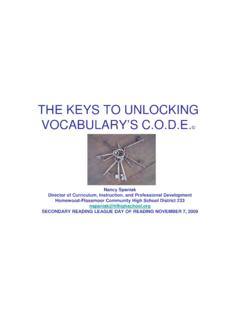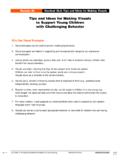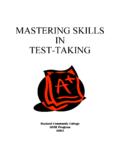Transcription of eye openers exploring optical illusions
1 MuseumofVisioneyeopenersexploringoptical illusionseyeopenersexploringopticalillus ionsmuseumofVisionTHE MISSION OF THE MUSEUM OF VISION IS TOEDUCATE PEOPLE ABOUT THE EYE AND VISION. 2000 by the Museum of Vision Foundation of the American Academy of Ophthalmology655 Beach Street, San Francisco, CA 94109-1336 The Museum has a variety of resources for people who arecurious about our most important sense vision. A collection of over 10,000 vision-relatedobjects, dating from the 300 BC to the present Interactive public outreach programs for children Traveling Exhibitions For more information, contact:Museum of Vision at 415-561-85002 INTRODUCTIONCHAPTER 1:HOW WE SEE; THE EYE AND THEHUMAN visual SYSTEM6 Key ConceptsParts of the Eye7 How do You See?8 How does the Eye Focus?9 ActivitiesName the Parts10 Draw Your Eye11 CHAPTER 2:BINOCULAR VISION12 ActivitiesDifferent Views13 Hole-in-Your-Hand15 Find Your Blind Spot17 CHAPTER 3:THE EYE-BRAIN CONNECTION20 Activities7 optical Illusions21#1:Train Tracks22#2: Rotating Staircase23#3: Barrel24#4: Kissing Lovebirds25#5: Smiling Frogs26#6:Two Straws27#7:Two Flowers28 CHAPTER 4:PERSISTENCE OF VISION30 ActivitiesMake a Spinning Disc (Thaumatrope)31 Make a Flipbook35 BIBLIOGRAPHY contentsEYE openers ptical illusions are pictures that play tricks onyour eyes and confuse your brain.
2 They arean enjoyable way of learning about the sci-ence of vision as well as a playful reminderthat our assumptions about the visual worldcan sometimes be optical illusions in this book illustrate three fascinating aspects of thehuman visual system: binocular vision, the eye-brain connection, and persis-tence of vision. Can you believe your eyes? Not will discover thatsome optical illusions trick us because we have two eyes (binocular vision).Others are the result of our brain remembering one thing while our eyes areseeing another (the eye-brain connection). Still other illusions happen becausewe think we still see an object after it has disappeared from view (persistenceof vision).How to use this first chapter of this book is an introduction tothe eye and the human visual system. Each of the following three chaptersfocuses on binocular vision, the eye-brain connection, and persistence ofINTRODUCTIONOCONTINUED vision.
3 They contain optical illusion demonstrations and activities designedto help students understand these is this book for? This book is designed for multiple uses, includingclassrooms, home schools, and museum some of the opticalillusions in this book can be appreciated by children of all ages, the book istargeted to students in the fourth, fifth and sixth grades. These children willbest be able to grasp the fundamental principles of vision discussed hope that Eye openers : exploring optical Illusionsprovides anenjoyable learning experience and stimulates interest in the science of openers FROM THE MUSEUM OF VISION6 HOWWE SEETHE EYEAND THEHUMANVISUALSYSTEMWHAT S IN THIS CHAPTER? Parts of the EyeHow Do You see?How Does the Eye Focus?Name the PartsDraw Your Eyekey conceptsactivityactivity1 There are many ways in which we experience andinterpret the world around us. Have you everthought what your world would be like if one ofyour five senses was lost or impaired?
4 Consider notbeing able to smell a rose, or taste a sweet orange, orhear a dog bark, or see a beautiful sensesfill our world with delightful sensations. Let s take acloser look at one incredible sense: is a complex eyes inform acomplex visual system that makes billions of calcu-lations every second. In fact, seventy percent of thebody s sense receptors are found in the though our eyes are, there isanother critical component needed to help us see our brain. Without it, vision would not be possiblefor us. In fact, it s the brain that drives our visual sys-tem. In this chapter, you will learn about the eye sanatomy and how the human visual system TO THEEDUCATORThis chapter includes background information onthe eye and the human visual system. The activitysheets can be xeroxed and handed out as refer-ences, or they can be used as overheads in a class-room openers FROM THE MUSEUM OF VISION71partseyeof thekey conceptCHAPTER ONE/HOW WE SEEThe pupil is the hole in the middle of your iris.
5 It changes size to let more or less light into your lens is clear and flexible. It changes shape to focus light onto your retina. The curved cornea bends light into your eye. It s tough and clear like a windshield and protects your eye from optic nerve carries the messages from your retina to your retina is the lining inside the back of your eye. Light-sensitive cells on the retina, called rods and cones, change light into messages that your brain iris is the colored part of your eye. It has two muscles that open and close your openers FROM THE MUSEUM OF VISION81howsee?do youkey conceptCHAPTER ONE/HOW WE SEE First, light bounces off objects all around you and entersyour eye. Then the light passes through your pupil and lens to theretina at the back of your eye. In the retina, the light makes an upside-down and back-wards picture. The retina contains light-sensitive cells (called rods andcones) that change the picture into messages that yourbrain understands.
6 The optic nerve carries these messages to your brain. Finally, your brain reads the messages and tells you whatyou re looking openers FROM THE MUSEUM OF VISION91howfocus?does the eyedistant objectrelaxed musclenear objectcontracted musclethickened lensrelaxed lenskey conceptCHAPTER ONE/HOW WE SEE You focus light with your cornea and lens. Your curved cornea bends light into your eye. Your lens changes shape to bring things into you look at things that are faraway, muscles in your eye relax and yourlens looks like a slim you look atthings that are close,muscles in your eyecontract and makeyour lens openers FROM THE MUSEUM OF VISION101 CHAPTER ONE/HOW WE SEEnamepartstheactivityCan you name the parts of the eye? Color and identify thedifferent parts of this eye cross section (answers on page 8).IrisRetinaLensPupilCorneaOptic NerveEYE openers FROM THE MUSEUM OF VISION111 CHAPTER ONE/HOW WE SEEdraweyeyouractivityDraw a picture of your eye (you might look in a mirror)and include these parts:Pupil Iris Eyelashes EyebrowWhen we ask, What color areyour eyes?
7 , weare really asking, What color areyour irises? What color areyour s? Whatcolor irises doyour friendshave?eye factEYE openers FROM THE MUSEUM OF VISION12 Humans see the world with two eyes. This is calledbinocular (bi-NOC-u-lur) vision, (bi means two,ocular means eye). However, since our eyes are abouttwo inches apart, each eye sees a slightly differentview. Our brain combines the views from our twoeyes and enables us to see things in vision helps us see depth. With 3-Dvision we know where things are in space. We canreach for a book or catch a you have to have two eyes to see depth?It helps, but even people who see with only one eyecan sense depth. That s because their brain picks upvisual clues from the world around them and learnshow to see S IN THIS CHAPTER? Different ViewsHole-in-Your-HandFind Your Blind Spotactivityactivityactivity2 EYE openers FROM THE MUSEUM OF VISION13 RECIPEDESCRIPTIONT eacher-led demonstrationPURPOSETo show students that each eye sees a slightly different viewLENGTH OFACTIVITY5 minutesMATERIALS noneW2 CHAPTER TWO / BINOCULAR VISION differentviewsCONTINUED activityEYE openers FROM THE MUSEUM OF VISION142 CHAPTER TWO / BINOCULAR VISION activitySTEPSRead the following instructions to your one Hold one arm straight out in front of Point with your finger at something in the room itcould be a corner where the ceiling and walls meet, or aflag, or a Don t move your finger!
8 5. Now switch Did it look like your finger moved? That s because eacheye sees a slightly different viewsEYE openers FROM THE MUSEUM OF VISION152 CHAPTER TWO / BINOCULAR VISION hole-handin-your-activityRECIPEWCONTINUE DDESCRIPTIONS tudents will create an optical illusionwith an every-day show that each eye sees a slightlydifferent view, and that the brain putsthe two views together to form OFACTIVITY15 minutesMATERIALS 1 cardboard tube (paper towel ortoilet paper roll works well) OR 1piece of paper per student (whichthe student will roll into a tube.)EYE openers FROM THE MUSEUM OF VISION162 CHAPTER TWO / BINOCULAR VISION hole-in-your-handactivitySTEPS Give each student a cardboard tube, or instruct the student toroll up a piece of paper and make it into a tube. Read the following instructions to your students:1. Hold the tube in your left hand and place it infront of your left eye. (Look throughthe tube as though you were lookingthrough a telescope.)
9 2. Keep both eyes open and look at anobject in the distance. (You can pickan object in the classroom forthe students to look at.)3. Hold your right hand in front ofyour face, with your palm facing Put the edge of your right hand (pinkie-finger side) next to ortouching the Do you see a hole in your hand?NOTE TO THEEDUCATORIf the students havetrouble seeing the holein their hand, havethem slide their righthand up or down thetube until they see it. Iftheir right hand is tooclose to their eye, theywon t see the eyesees thisRight eyesees thisYour brain putstogether whatyour left andright eyes factWhen you lookthrough the tube andsee a hole in yourhand, you are seeingan optical through thetube into the distancewith your left eye,and you looked atyour right hand withyour right took what yourleft eye saw and whatyour right eye sawand put them togeth-er into one picture a hole in your hand!RECIPEWEYE openers FROM THE MUSEUM OF VISION17 DESCRIPTIONS tudents will make a simple propand use it to find their blind show students how to find theirblind OFACTIVITY20 minutesMATERIALS One 3 x 5 index card (or otherstiff paper) per student black markers 1 ruler per student2 CHAPTER TWO / BINOCULAR VISION findblind spotyourCONTINUED activityEYE openers FROM THE MUSEUM OF VISION182 CHAPTER TWO / BINOCULAR VISION find your blind spotactivitySTEPS1.
10 Make a dot and an X on the index card as shown:2. Hold the card at eye level about an arm s length sure the X is on the Close your RIGHT Look directly at the X with your LEFT eye. Notice thatyou can also see the Focus on the X, but be aware of the dot, as you slowlybring the card towards your face. At some point the dotwill disappear, and then s your blind Now close your LEFT eye and look directly at the dotwith your RIGHT time the X will disappear andreappear as you bring the card slowly toward your openers FROM THE MUSEUM OF VISION192 CHAPTER TWO / BINOCULAR VISION find your blind spotactivityNOW TRY THIS(optional)1. Draw a straight line across the card, from one edge tothe other, through the center of the X and the Do the activity Notice that when the dot disappears, the line appears tobe continuous, with no gap where the dot should brain automatically fills in the blind spot withwhat it thinks should be the back of your eye is your retina.




